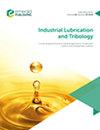使用热机械耦合模型和速度相关摩擦模型模拟 Ti6Al4V 的高速加工过程
IF 1.5
4区 工程技术
Q3 ENGINEERING, MECHANICAL
引用次数: 0
摘要
目的 本研究旨在建立热耦合二维正交切削模型,以进一步改进建模过程,从而系统地评估材料损伤、刚度退化、等效塑性应变和其他材料特性,以及切削温度分布和切削力。本研究建立了一个二维正交切削热机械耦合有限元模型。采用 tanh 材料构成模型模拟材料的机械特性。考虑了工件与刀具之间与速度相关的摩擦模型。通过计算评估了切削过程中的材料损伤、刚度退化、等效塑性应变和温度场等材料特性。研究结果与速度相关的摩擦模型预测的切削力误差低至 8.6%。社会影响目前的研究成果为理解和控制金属切削中的刀片摩擦提供了见解,为摩擦建模和加工仿真工作提供了实用建议。原创性/价值本研究的原创性得到保证,因为它以前未在任何期刊或出版物上发表过。同行评审本文的同行评审历史可在以下网址查阅:https://publons.com/publon/10.1108/ILT-05-2024-0162/。本文章由计算机程序翻译,如有差异,请以英文原文为准。
High-speed machining simulation of Ti6Al4V using a thermo-mechanical coupling model and velocity-dependent friction model
Purpose
This study aims to establish a thermally coupled two-dimensional orthogonal cutting model to further improve the modeling process for systematic evaluation of material damage, stiffness degradation, equivalent plastic strain and other material properties, along with cutting temperature distribution and cutting forces. This enhances modeling efficiency and accuracy.
Design/methodology/approach
A two-dimensional orthogonal cutting thermo-mechanical coupled finite element model is established in this study. The tanh material constitutive model is used to simulate the mechanical properties of the material. Velocity-dependent friction model between the workpiece and the tool is considered. Material characteristics such as material damage, stiffness degradation, equivalent plastic strain and temperature field during cutting are evaluated through computation. Contact pressure and shear stress on the tool surface are extracted for friction analysis.
Findings
Speed-dependent friction models predict cutting force errors as low as 8.6%. The prediction errors of various friction models increase with increasing cutting forces and depths of cut, and simulation results tend to be higher than experimental data.
Social implications
The current research results provide insights into understanding and controlling tool-chip friction in metal cutting, offering practical recommendations for friction modeling and machining simulation work.
Originality/value
The originality of this research is guaranteed, as it has not been previously published in any journal or publication.
Peer review
The peer review history for this article is available at: https://publons.com/publon/10.1108/ILT-05-2024-0162/
求助全文
通过发布文献求助,成功后即可免费获取论文全文。
去求助
来源期刊

Industrial Lubrication and Tribology
工程技术-工程:机械
CiteScore
3.00
自引率
18.80%
发文量
129
审稿时长
1.9 months
期刊介绍:
Industrial Lubrication and Tribology provides a broad coverage of the materials and techniques employed in tribology. It contains a firm technical news element which brings together and promotes best practice in the three disciplines of tribology, which comprise lubrication, wear and friction. ILT also follows the progress of research into advanced lubricants, bearings, seals, gears and related machinery parts, as well as materials selection. A double-blind peer review process involving the editor and other subject experts ensures the content''s validity and relevance.
 求助内容:
求助内容: 应助结果提醒方式:
应助结果提醒方式:


